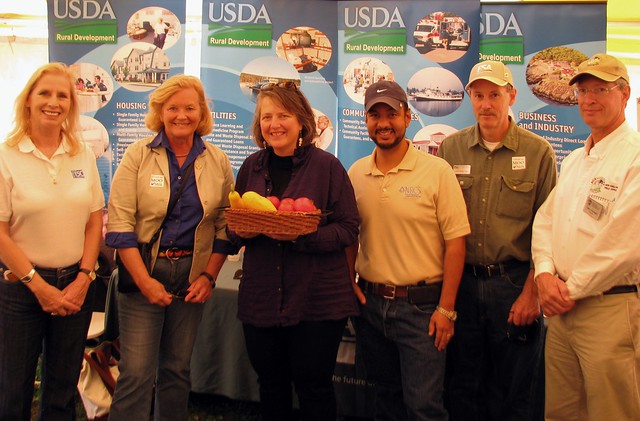Staying on the topic of the US Farm Bill being currently discussed, here is some uplifting news: The Local Farms, Food and Jobs Act which Congresswoman Chellie Pingress introduced (originally in 2011!) has found widespread bipartisan support in both House and Senate Agricultural Committees, and many ideas from the act have been adopted into the draft bills that were adopted in the past week.

Image by USDA.
The Congresswoman from Maine’s main argument in favor of her bill:
“Farm policy in this country has been skewed in favor of big agribusinesses but in the last year we’ve made some significant progress in reforming it in favor of local, sustainable farms. These ideas are rapidly becoming more mainstream as consumers realize that local food isn’t just good for their families but it’s good for the local economy too.”
Thus, currently, these are some of the innovative policies that have been taken up in at least one of the two draft Bills (This list draws heavily on the Congresswoman’s website, but I added some of my thoughts):
- Farm-to-school programs that will allow schools to use their federal commodity funding to buy food from local farmers (side note: it seems absurd that this isn’t allowed yet.)
- Increasing access to local food for SNAP (food stamp) recipients, including a program to provide electronic benefit card readers to farmers markets at no cost; a double-voucher program to increase the buying power at direct-to-consumer outlets; and a provision to make it easier for SNAP dollars to be spent on Community Supported Agriculture (CSAs). There have already been first attempts to make SNAP acceptance in farmers’ markets more available, but many farmers still see administrative and bureaucratic hurdles involved; hopefully this will make it easier and more straightforward for both consumers and producers.
- Diversified crop insurance, which will insure a whole diversified farm, not just insurance per row crop. According to the Congresswoman’s website, “diversified producers […] do not currently have access to revenue insurance geared to their farming systems.” Again, it’s surprising that this hasn’t been the case yet, since in my Risk Management class we learned that diversification already contributes significantly to risk mitigation (you aren’t putting all your eggs in one basket); insurers should be glad to take on less risky clients!
- Organic crop insurance, which treats organic farmers more equitably and will give organic farmers a fair price for their food. Organic products have a clear price premium in the market that farmers factor into their bottom line and depend on – if they experience a bad year and get reimbursed at the non-organic price rate, it might make them incur a significant loss and drive them out of business.
- Value-added producer grants, which will significantly assist in re-establishing food system infrastructure in rural areas. The grants will help target and strengthen the profitability and competitiveness of family farms.
- Establish a Food Corps program for community service members to connect schools to local farms and engage K-12 students in experiential learning about agriculture, gardening, nutrition, cooking, and where their food comes from. That sounds like such an exciting project! It reminds me of the Green Bronx Machine I blogged about recently. And we desperately need to reconnect our next generation with a better understanding of our food systems, so I’m all for it.
All in all, it sounds like an extremely laudable effort by the Congresswoman to introduce the idea of local food systems into the behemoth of a policy framework that is the Farm Bill. Her original Act had some additional ideas that don’t seem to have survived the transition into the Farm Bills (at least they are not on her list), though.
These include Agricultural Research and Extension funding that focused on local food systems (particularly interesting for a current grad student potentially interested in staying in academia 😉, providing customer-friendly electronic access to meat labels; or providing food safety and inspection outreach, technical assistance, and training to small meat and poultry establishments (which is instrumental for small establishments to survive in a highly competitive market with a large financial burden in relation to food safety). I think those additional ideas would be very valuable too for the increased transparency of the food industry and to support local food systems in their competitiveness. Also, particularly in the House bill it seems ironic that SNAP benefits will be extended to farmers’ markets and CSAs and yet cut by $20.5 million…
However, baby steps! It will be interesting to see whether all this legislation survives the floor debates unharmed!
Bonus: The Congresswoman (or her staff, at least 😉 also maintains a tumblr with updates on local food policy, if you want to know more about her and others’ work on this issue in Congress.
Is this something that we should call on our congress to support or is it premature at this time?
I think you should definitely get involved and tell your representatives to support these ideas as well! I found that the Union of Concerned Scientists has a page set up here (https://secure3.convio.net/ucs/site/Advocacy?cmd=display&page=UserAction&id=3623) to let you urge your rep to cosponsor the Local Food, Farms and Jobs Act (which might mean to get all of Pingress’ ideas into the Farm Bill).